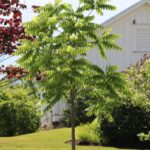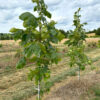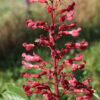
Quercus macrocarpa, the bur or mossycup oak, is typically in form a large deciduous tree, but highly variable; ranging from well over 100 ft tall in moist situations in southern parts of its range to a shrub in drylands and far northern areas. Its native range extends from north Texas northeastward through the central and northern Appalachians and north through the Great Plains into southern Manitoba, Ontario and Quebec. It grows further north than any other oak native to North America and is cold-tolerant to USDA zone 3.
As a wide-ranging species, Q. macrocarpa tolerates a broad range of soil and moisture conditions, ranging from rich river bottomlands to dry rocky outcroppings. It is exceptionally drought-tolerant when established, with a broad root system and a deep central taproot. Prior to the arrival of Europeans in North American, bur oak was among the most prevalent trees in the Upper Midwest and North Plains, anchoring the oak savanna ecosystem. This grassland and oak ecosystem was frequently swept by wildfires due to seasonal precipitation variances, but the thick bark of bur oak allowed the tree to easily withstand these fast-moving flames. As a predominant tree of that ecosystem, Q. macrocarpa was a primary fuel and lumber source for migrants spreading westward from the eastern US and Canada in the early 19th century, such that few patches of original oak savanna remain.
[Article continues below photos.]
As member of the white oak group, Q. macrocarpa has characteristic round-lobed, unbristled leaves. They are a leathery dark green in summer, 6 to 12 inches long with many lobes, the middle one usually especially deep, visually dividing the leaf into two parts. Autumn color is usually gold to golden-brown. As mentioned above, the ashy-grey to brown bark is exceptionally thick and scaly, developing deep vertical grooves as the tree ages. As an oak, male and female flowers are borne separately on the same tree, the male in the form of greenish-yellow catkins and the female as small green and red spikes; both are aesthetically insignificant and emerge with the leaves in spring. Q. macrocarpa exhibits a very strong masting behavior in acorn production, where acorns are sparsely produced in most years, with a very heavy crop every four to ten years. This is believed to be an evolutionary adaptation to overcome the heavy feeding of wildlife on acorns (reducing the wildlife population in light acorn production years) and a low germination rate; typically only 0.01% to 0.1% of acorns produce a viable tree in the wild. The acorns are the largest of any North American native oak and are enclosed in a deep, burry cup that often attracts moss spores due to moisture retention. The Latin specific name macrocarpa ’literally translates as ‘big seed’.
In habit, the bur oak is among the faster-growing oaks, with a typical rate of one to two feet per year when young with an oval crown. As the tree matures, it becomes more massive, with a crown broader than tall and anchored by many relatively low, thick branches. Although tolerant of some light shade, the species strongly prefers an open, sunny situation. As an oak, it is susceptible to several pests, including galls and gypsy moth damage, but the species appears to be more tolerant of two often-fatal fungal diseases, sudden oak death (SOD) and oak wilt than the more vulnerable red oak group. The wood, like most oaks, is hard and durable, and is used most frequently today for flooring and cabinetry, but historically was a preferred lumber for wagon wheels and tongues, ox yokes, and barrels due to its strength. The acorns are a favorite food of several native species, including wood ducks, wild turkeys, white-tailed deer, rabbits, mice, squirrels, and black bears.
For the landscape, Q. macrocarpa is a valuable tree for more open properties and large lawns, where it has sufficient room to mature to its broad and beuatiful form. WHN supplies bur oak in 2”, 2½” and 3”caliper. It’s definitely not for every landscape, but where it has the room to grow, it can be a spectacular native specimen.







